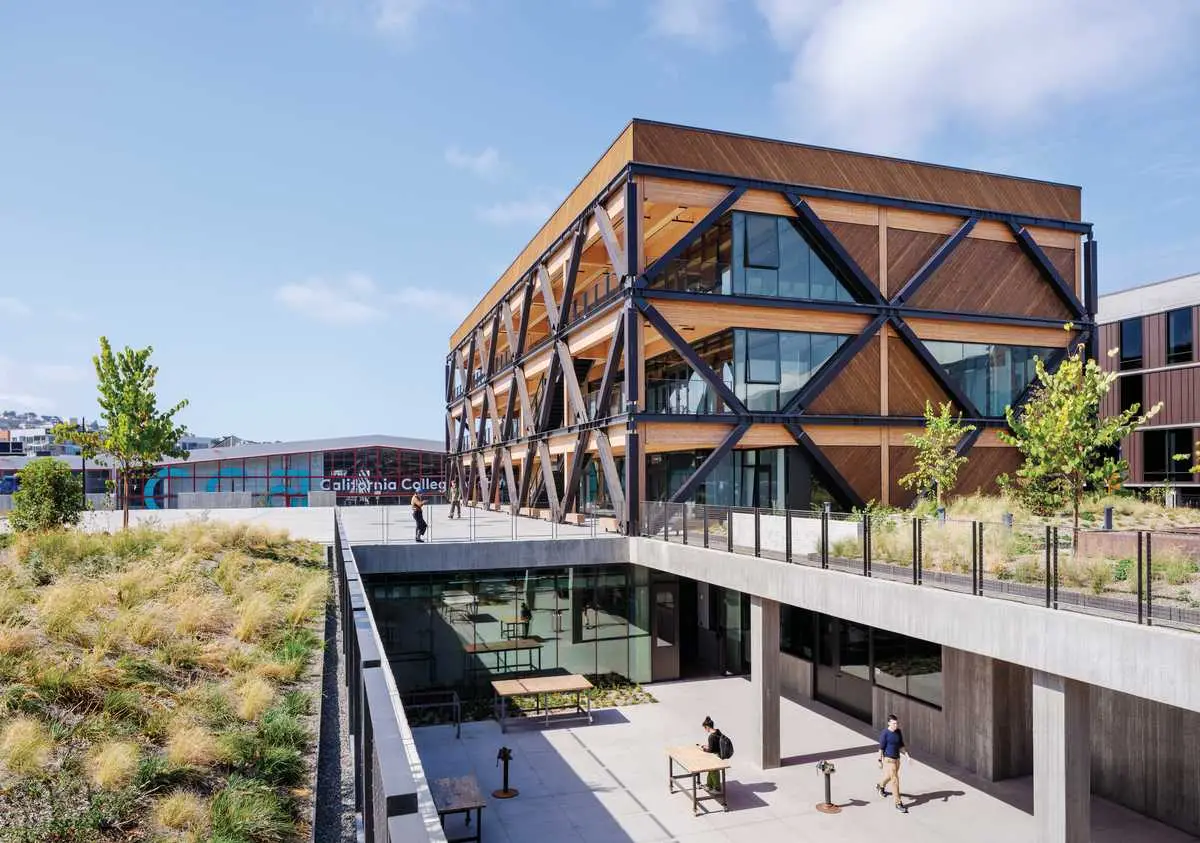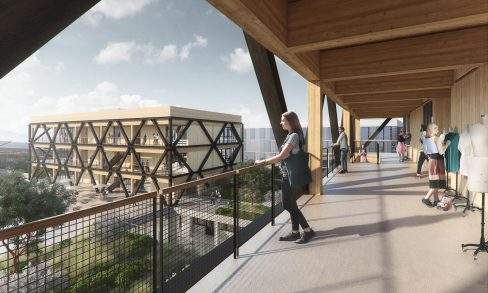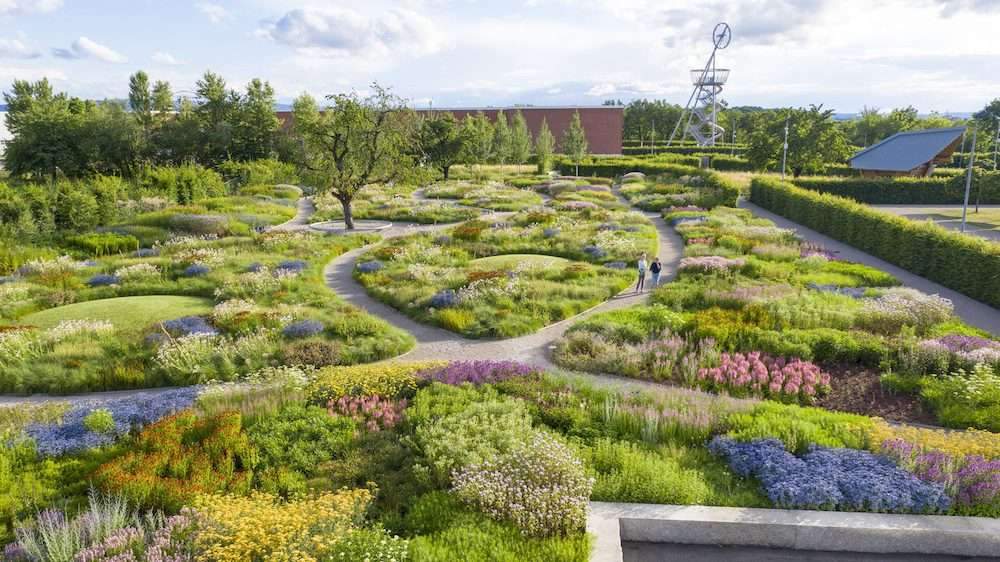For 24 years, the California College of the Arts’ 33 academic programs were spread across two campuses: the verdant, Victorian-era former James Treadwell estate in Oakland and a converted Greyhound-bus maintenance shed in San Francisco’s emergent Design District. Two art-learning cultures took shape as different as the sites. In Oakland, faculty and students channeled the school’s Arts & Crafts DNA in buildings, some over a century old, learning and making indoors and out. In San Francisco, the feel is more factorylike, an open plan of studios and classrooms bordering a giant central “makers yard” in the high-vaulted shell of a vintage 1951 SOM Modernist industrial design.

When Studio Gang won a 2016 competition to merge the campuses with a single expansion adjacent to the bus shed, its research with faculty, students, and board members yielded many hopes for bringing the two worlds together, all with lightest possible touch on the environment. But the parti, says founding partner Jeanne Gang, emerged from the staff members who are so often an art school’s backbone: the shop managers. “They’re not just managers,” says Gang. “They’re the ones who help students make things. There’s a whole shop culture.”
Gang describes the addition, which opened in October, “as basically just a big makerspace with a garden on top.” Calling it “Double Ground,” Studio Gang’s team has crafted an elegantly minimalist synthesis of the two campus environments, the college’s ambitious sustainability goals, and (it being San Francisco) seismic resiliency.
The first floor’s 57,000-square-foot concrete-enclosed expanse unfolds in a veritable agora of high- and low-tech labs and shops for furniture-making, CNC fabrication, spray-painting, chemical mold-making, ceramics, screen printing, lithography, digital fabrication, sandblasting, and one known simply as “Hammer Room,” for metalsmithing jewelry. Two glass-shrouded, open-air “maker yards” provide outdoor space, to build and display work, while welcoming daylight deep into the interior.
1The studio pavilions sit atop the “upper ground,” while cutouts in this second-level slab reveal maker yards (1 & 2). Photos © Jason O’Rear, click to enlarge.
2
The second level is, indeed, a garden: 16,000-plus square feet, designed with landscape architect Surfacedesign, including a grassy playing area, a hardscape plaza, clusters of native plants, a dye-plant garden, and a wide set of bleachers for gathering. Atop it sit two three-story pavilions (with future plans for a third) housing classrooms, studios, and the college’s noted gallery, the Wattis Institute for Contemporary Arts. By pushing all circulation to the perimeter with 11-foot-wide open-air covered walkways, the pavilions channel the easy indoor/outdoor flow of the old Oakland campus.
From the outset, the college and Studio Gang set the ambitious goal for operational carbon neutrality. An art school’s equipment usage and ethos worked both for and against those aims, according to Kristen DiStefano, director of the San Francisco office of the project’s sustainability consultant, Atelier Ten. The pavilions’ outdoor circulation provides sunshading and night-flushing to cool spaces, for instance. But similar passive strategies didn’t make sense at the shop level, with students working odd hours and equipment like kilns firing overnight.
So, Atelier Ten’s team convinced the college to adopt “a slightly wider band of comfort in the new building,” according to DiStefano. Students and staff, she notes, were already acclimated: the bus shed was never retrofitted with a cooling system. Carbon-neutral operations remain in the future but can be readily achieved. Atelier Ten laid the groundwork by designing the necessary infrastructure for a microgrid: battery storage with power supplied by photovoltaics that, when eventually installed over the bus shed and a nearby student residence, will fully power the new building. In the meantime, modeling predicts the building will use 27 percent less energy than an equivalent one designed to meet the ASHRAE 90.1 2010 standard. However, that metric doesn’t tell the whole story, says DiStefano, since more efficient shop equipment should reduce demand even further.
“Up until this project, our firm, and the construction industry as a whole, has been focused on annual energy use as a metric,” says DiStefano. “But, with the school’s emissions changing every hour of the day, we developed an overlay to our analysis that allows us to track variations in energy demand but also relate that to the future microgrid.”
Working with Arup, Studio Gang similarly synthesized carbon sequestration and seismic performance in a novel structural system. The pavilions are framed by glulam columns and beams, supporting 8-foot-wide, 6-inch-thick cross-laminated timber panels, all in black spruce. This assemblage is wrapped by an eccentric braced frame of 12-inch-square Douglas fir glulam members and steel connections. As Arup senior engineer Kion Nemati explains, with the gravity loads carried by the post-and-beam system, the brace frame could remain unclutteredby the typical vertical members beyond the corners. Peer-reviewed, the structure should perform at the upper range of California’s seismic requirements. Douglas fir, Nemati notes, is more susceptible to water infiltration than other species, so every connection was carefully detailed to shed water, and Arup specified a new pressure treatment that the fir more deeply absorbs. Contrasting the spruce with a dark stain, the brace frame is a striking basket weave wrap that channels the college’s Arts & Crafts roots.
Overall, Atelier Ten’s assessments found the choice of the lighter hybrid-timber/steel structure, the minimal interior finishes, and the carbon sequestered in the wood reduced the embodied carbon by 49 percent, compared to that of a baseline building, says DiStefano.
Of course, the ultimate measure of any building’s environmental success is its adaptability to change. CCA is facing a lot of it. As the addition opened, enrollment is down, and the college is facing a $20 million deficit never imagined at the project’s conception. CCA is hardly alone. Sister schools like the San Francisco Art Institute, Philadelphia’s University of the Arts, and others have even abruptly closed.
Gang and CCA’s president, David Howse, quickly dismiss the question of whether the addition could be repurposed for uses beyond art education. But both praise the building’s general “hackability” for the new equipment, techniques, and art forms to which any art school must routinely adapt.
“I’m always cognizant of how flexible I can make a building,” says Gang. “This one is extremely flexible, but I hope it doesn’t ever have to have another use,” she says.
Interviewed days after the first classes began, Howse praised what he called the building’s “bump rate” of spontaneous conversations and connections among students and faculty in all the shops. “It’s doing exactly what it was designed to do: act as a container for more interdisciplinary collaboration,” he says. “I hadn’t anticipated feeling that so soon.”
Click plan to enlarge
Click section to enlarge
Click detail to enlarge
Credits
Architect:
Studio Gang — Jeanne Gang, founding partner; Steve Wiesenthal, campus-environments principal; William Emmick, design-management principal; Olesya Vodenicharska, project leader
Associate architect:
TEF Design
Consultants:
Arup (structure, acoustics); MEYERS+ (m/e/p/fp); Lotus Water (civil); Surface Design (landscape); Atelier Ten (sustainability); PritchardPeck (lighting)
General Contractor:
Hathaway Dinwiddie Construction
Client:
California College of the Arts
Size:
82,300 square feet
Cost:
$95 million (construction)
Completion Date:
October 2024
Sources
Mass Timber:
Nordic Structures
Podium:
CEMEX
Glass:
GlasPro
Curtain Wall:
YKK
Skylights:
Solatube, TCG Glass
Hardware:
Schlage, Assa Abloy, LCN, Dorma, Von Duprin, Ives, Forster
Cabinetwork and Paneling:
States Industries
Plastic Laminate:
Formica
Paints and Stains:
Sherwin-Williams
Floor and Wall Tile:
Daltile



